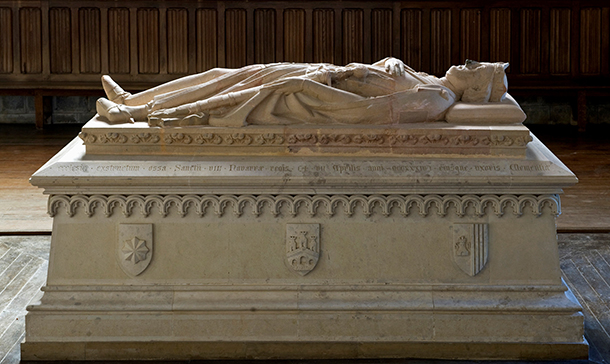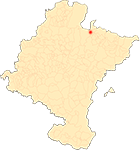Roncesvalles
By Javier Martínez de Aguirre Aldaz
Sepulchre of Sancho VII the Strong
One of the most significant medieval creations at Roncesvalles is the tomb of Sancho VII, which today is in the chapel of San Agustín. It originally culminated in a tomb tomb decorated with figures located in the middle of the church, next to the grille of the presbytery and the wooden figure of his wife Clemencia (according to an old description, "the royal tomb had many figures around it inside the grilles, of angels, clerics and religious figures, already consumed and weeping"). During a move during the 17th century alterations, the slab was broken and buried, and report was saved for its location, which allowed it to be found at finding in 1890. It was restored and replaced in 1912, on the occasion of the centenary of the Battle of Las Navas.
The statue measures 2.25 m from crown to feet. The king, nicknamed the Strong, was undoubtedly a person of great physical strength, as sung in poems of his time. An anthropometric study based on the measurements of the femur made it possible to estimate that he could have been between 2.22 and 2.31 m tall. He is shown crowned, wearing a wide cloak held at the right elbow and armed with a sword and spurs. One of the most striking features is the crossing of the legs. This posture is not uncommon in Gothic tombs, and is particularly common in England, where in the 18th century it was explained as being typical of knights who had died without fulfilling their vow to participate in the Crusades. There the knights often hold their swords, which is not the case at Roncesvalles, where the king rests his left hand on the scabbard while holding his right hand to his heart and holding the buckle of the cloak with one finger. This relationship with English works has led us to believe that the sculptor had this origin. Cross-legged recumbent statues were also made in Castile in the last third of the 13th century, and therefore later than this one. It is a correct work, lacking finesse in the treatment of the face, but which resolves the folds of the cloak with official document and a certain rigidity, both in its cascading lateral fall and in the fans of the lower part.
Dectot, X., "Yacente de Sancho VII el Fuerte", in Bango Torviso, I.G. (dir. cient.), Sancho el Mayor y sus herederos. El linaje que europeizó los reinos hispanos, Pamplona, 2006, pp. 371-373.
Fernández-Ladreda, C., Imaginería medieval mariana en Navarra, Pamplona, 1989.
Fernández-Ladreda, C. (Dir.), Martínez Álava, C., Martínez de Aguirre, J. and Lacarra Ducay, M.C., El arte gótico en Navarra, Pamplona, 2015.
Fuentes y Ponte, J., report histórica y descriptiva del santuario de Nuestra Señora de Roncesvalles, Lérida, 1880.
García Gainza, M.C., Orbe Sivatte, M. and Domeño Martínez de Morentin, A., Catalog Monumental de Navarra IV**. Merindad de Sangüesa, Pamplona, 1992.
Ibarra, J., History of Roncesvalles. Art. History. Legend, Pamplona, 1936.
Lambert, E. Roncevaux", Bulletin Hispanique, XXXVII (1935), pp. 417-436.
Martínez de Aguirre, J. (coord.), Enciclopedia del Románico en Navarra, Aguilar de Campoo, 2008, vol. III, pp. 1216-1224.
Martínez de Aguirre, J., Gil Cornet, L. and Orbe Sivatte, M., Roncesvalles. Hospital and sanctuary on the Camino de Santiago, Pamplona, 2012.
Miranda García, F. and Ramírez Vaquero, E., Roncesvalles, Pamplona, 1999.
Peris, A., "El Ritmo de Roncesvalles: estudio y edición", Cuadernos de Filología Clásica. Latin Studies, 11 (1996), pp. 171-209.
Pons Sorolla, F., "project de obras de restauración en la capilla del Sancti Spiritus de la Real Colegiata de Roncesvalles (Navarra)", Príncipe de Viana, XXXIX (1978), pp. 59-77.
Soria i Puig, A., The Road to Santiago. II. Stations and signs, Madrid, 1992.
Torres Balbás, L. La iglesia de la hospedería de Roncesvalles", Príncipe de Viana, VI (1945), pp. 371-403.
Thuile, J., L'Orfèvrerie en Languedoc du XIIe au XVIIIe siècle. Généralité de Montpellier, Montpellier, 1966.












